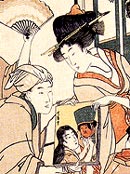

NAKAO Toshikaka (中尾義隆)
|
 Nakao Toshikaka (中尾義隆), 1911-1994, was born in Ehime Prefecture. He was a mostly self-taught printmaker, although he did some work with Azechi Umetarô. Yoshitaka became well respected in Japanese print-making circles after he won awards at Kokugakai (National Picture Association: 国画会)) exhibitions in 1949 and 1956.
Nakao Toshikaka (中尾義隆), 1911-1994, was born in Ehime Prefecture. He was a mostly self-taught printmaker, although he did some work with Azechi Umetarô. Yoshitaka became well respected in Japanese print-making circles after he won awards at Kokugakai (National Picture Association: 国画会)) exhibitions in 1949 and 1956.
Yoshitaka is known for using cement-blocks to print his images, a technique characterized by pouring wet cement into hand-made wooden frames and then scoring into the mixture as it dried. This medium dominated his oeuvre until 1955. Later, he used woodblocks in a more conventional manner, although often with oil-based pigments, and he did not abandon his cement prints. Yoshitaka's use of cement-paste in printmaking is akin to the technique found in the better known works of Haku Maki.
Some of Yoshitaka's designs were large in scale. An untitled woodblock print from 1957, with oil pigments and scored cement paste and measuring 840x560 mm, depicts a standing, monolithic female figure with one arm wrapped around her head, the other encircling her chest. It has been reproduced in several books (see Michener and Kawakita references below).
The Graphic Society of New York published his prints on three occasions in the 1960s. Yoshitaka's works are included in the collections of the National Gallery of Art in Washington DC, the Art Gallery of Greater Victoria, and the Fine Arts Museums of SF (Achenbach Collection, Legion of Honor).
The work illustrated here is similar in form and impact to the figure from 1957. Untitled, it shows a three-quarter-length figure of a woman combing or washing her hair. It is signed Y. Nakao, dated 1961, and numbered 18/90. Another large-scale work, the paper size is 865x548 mm. The bright opacity of the oil pigments and the textures created by the cement paste were illustrative of his method. The shock of red colorant for the face punctuates and enlivens the design. ©2019 by John Fiorillo
BIBLIOGRAPHY
- Kawakita, Michiaki:Contemporary Japanese Prints. Tokyo: Kodansha, 1967, no. 85.
- Merritt & Yamada, "Guide to Modern Japanese Woodblock Prints," p. 106.
- Michener's Japanese Prints from the Early Masters to the Modern (no. 246)
- Till, Barry: Japan's Modern Prints. Art Gallery of Greater Victoria (Exhibition, Jun 7 - July 22, 1984; cat. no. 20b).
Viewing Japanese Prints |